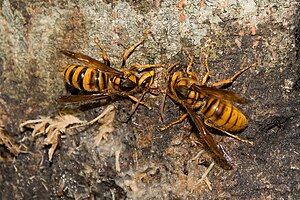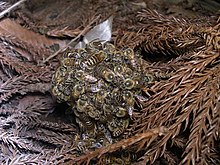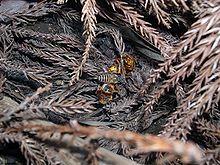Vespa simillima
This article has been registered in the quality assurance biology for improvement due to formal or content-related deficiencies . This is done in order to bring the quality of the biology articles to an acceptable level. Please help improve this article! Articles that are not significantly improved can be deleted if necessary.
Read the more detailed information in the minimum requirements for biology articles .
| Vespa simillima | ||||||||||||
|---|---|---|---|---|---|---|---|---|---|---|---|---|

Vespa simillima |
||||||||||||
| Systematics | ||||||||||||
|
||||||||||||
| Scientific name | ||||||||||||
| Vespa simillima | ||||||||||||
| Smith , 1868 | ||||||||||||
| Subspecies | ||||||||||||
|
Vespa simillima is a common hornet species in the eastern hemisphere.
description
The subspecies V. s. simillima is darker and more hairy than V. s. xanthoptera . The subspecies Vespa simillima xanthoptera , common in Japan, is known as the Japanese yellow hornet . It is not to be confused with the subspecies of the Asian giant hornet , the Vespa mandarinia japonica .
Phylogeny and Taxonomy
Vespa simillima belongs to a 2013 by Perrard et al. on the basis of morphological and DNA sequence investigations proposed cladogram for the Vespa bicolor species group . This was confirmed as monophyletic in genetic analyzes (based on the comparison of the DNA sequence of homologous genes) .

Way of life
In this species, as with many social wasps , new nests are established by a single, mated young queen. The queen starts building the nest alone and is later supported by the newly hatched workers. Colon sizes can reach up to 2000 workers. Their occurrence is particularly problematic for beekeepers , because Vespa simillima can severely weaken colonies as a bee hunter. The eastern honey bee can, however, defend itself against attacks with a heat ball .
Web links
Individual evidence
- ↑ Adrien Perrard, Kurt M. Pickett, Claire Villemant, Jun-ichi Kojima, James Carpenter (2013): Phylogeny of hornets: a total evidence approach (Hymenoptera, Vespidae, Vespinae, Vespa). Journal of Hymenoptera Research 32: 1-15. doi : 10.3897 / YEAR 32.4685 .
- ↑ Michael Archer (1996): Taxonomy, distribution and nesting biology of the Vespa bicolor group (Hym., Vespinae). Entomologist's Monthly Magazine 130: 149-158.
- ↑ Suzanna Persson (2015): Phylogeny and taxonomy of the subfamily Vespinae (Hymenoptera: Vespidae), based on five molecular markers. Degree project for Master of Science, University of Gothenburg.
- ↑ M. Ono, T. Igarashi, E. Ohno, M. Sasaki: Unusual thermal defense by a honeybee against mass attack by hornets (Vespa mandarinia japonica). In: Nature . (1995) 377, pp. 334-336.
